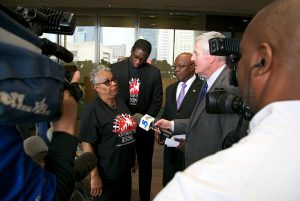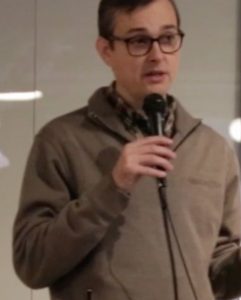Archive for March 2019
Southern Sector Rising Went Eyeball to Eyeball with Dallas City Hall over Shingle Mountain. Dallas City Hall Blinked.
After a year of excuses, a determined group of women and their supporters shamed the City into finally taking action to close down the worst environmental health and justice crisis in Dallas.
When the collapse came, it came quickly.
Halfway through their Wednesday March 20th news conference giving authorities an ultimatum to shut down “Shingle Mountain” or face protests and possible civil disobedience, members of the freshly minted Southern Sector Rising Campaign for Environmental Justice learned the City of Dallas was reversing course and moving to close Blue Star’s year-old asphalt hell.
Only a week before, the official party line from City Hall was that the self-described “recycler” had all the permits it needed. Staff said critics’ description of Blue Star’s operation as an illegal dumping ground was wrong. It had “a right to be there.”
Now, on Wednesday….well, now circumstances had changed. The political circumstances that is.
Now there was a new coalition of frustrated Southern Dallas residents and Old School Icons like Peter Johnson, Luis Sepulveda and John Fullenwider staging an emotionally-charged news conference with chants of “Shame on Dallas” ringing loudly up and down the corridors of City Hall. Now there was a publicly-leaked report with incriminating evidence of official wrongdoing. Now there were swarms of cameras and reporters hanging on the every word of a middle-aged, middle-class, horse-loving DART employee who had been ignored for such a long time.
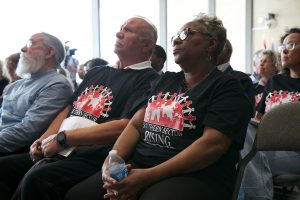
Three Generations of Dallas Environmental Justice Advocates: John Fullenwider, Luis Sepulveda and Marsha Jackson
Led by Marsha Jackson and her Choate Steet neighbors, Temeckia Durrough and Miriam Fields of the Joppa Freedman Town Association and Olinka Green from the Highland Hills Community Action Committee, with Stephanie Timko as media czarina, the Southern Sector Rising Campaign for Environmental Justice did more than just win a huge victory for an much-abused part of Dallas. It gave Southern Dallas residents a new model for effectively changing their circumstances.
An ad-hoc group that hadn’t even existed in February had the temerity to put City Hall on trial in its own lobby for Big D’s most spectacular municipal act of environmental racism in years. And it wasn’t even a fair fight.
An eye-opening state inspector’s report Downwinders sent to reporters a few days before the news conference officially documented permit violations and red flags too large to defend. Although Blue Star had promised the state in April 2018 it wouldn’t store more than 260 tons of waste at its site, it was already storing 60,000 tons in December. Blue Star was supposed to have a Fire Protection Plan. It didn’t. Blue Star was supposed to have adequate funds to close and clean up its site. It didn’t. Blue Star was supposed to randomly test incoming loads of shingles for asbestos. It didn’t.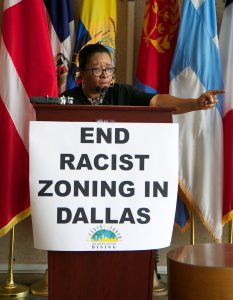
This is how bad it was: Blue Star’s mocking of the law was too much even for Gregg Abbott’s Texas Commission on Environmental Quality. Or the City of Dallas.
So long before the last speaker spoke in the Flag Room, news came that the City had pulled the Certificate of Occupancy for the largest of the two Blue Star tracts, something it had previously said wasn’t possible. Then it announced it was taking the company to court the next day to get an emergency Temporary Restraining Order to close Blue Star down.
That City staff could so shamelessly pull off such a dramatic flip flop over a matter of a few hours is testimony to both the fury fueling the Campaign, and the overwhelming evidence that Blue Star and its government enablers had allowed a full-blown illegal dump to grow… and grow…and grow. The only thing missing from the turnaround was an apology and acknowledgement to the women that had forced City Hall’s hand.
In Thursday’s hearing on the Restraining Order, the City of Dallas cited a number of missing municipal and state permits it now said Blue Star needed, including a Special Use Permit, an air quality permit, and a permit for storage in the flood plain – none of which the City had demanded when Blue Star had opened for business a year earlier. Despite the lack of these permits the City was now saying were essential, it had kept telling reporters, Council Members, and residents alike that Blue Star was a legal business right up until the time of the news conference.
It wasn’t. Ever. But it took a group of frustrated Southern Dallas residents to expose that lie.
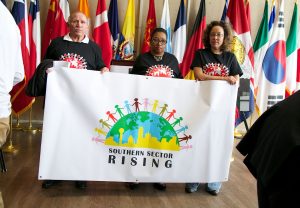 Of course in the hearing itself the heretofore lack of official city concern about these lacking permits was perturbing in the extreme for the attorney representing Blue Star, who said City Hall had already signed-off on its operations.
Of course in the hearing itself the heretofore lack of official city concern about these lacking permits was perturbing in the extreme for the attorney representing Blue Star, who said City Hall had already signed-off on its operations.
“The City told my client there were NO air quality problems,“ he protested to the judge. That was undoubtedly a true statement. But that conclusion was rendered before a brigade of angry residents showed up at City Hall demanding Dallas enforce the law.
Now, presto-chango, the City was emerging out of its dilapidated telephone booth with its moldy Toxic Avenger costume on and finding plenty of air quality problems, albeit in a anecdotal, non-quantifiable, way.
Because despite being “very concerned” about air pollution from Blue Star, the City of Dallas never monitored air quality from the facility before it got to court. Neither did the state. Only Downwinders at Risk, plugging-in one of our own portable PM monitors on the top of Marsha Jackson’s window unit for days at a time, captured any credible scientific evidence of air pollution harms.
Those results were released at the March 20th news conference and showed levels of Particulate Matter pollution that UNT’s Dr. Tate Barrett concluded “poses a significant health risk to the residents.”
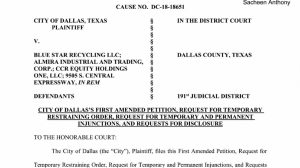
But in court, the City didn’t even mention those EPA-calibrated results.
For the first time in memory it was the regulators using only their senses to call for a crackdown – what they saw and heard and smelled at Blue Star’s site – and citizens showing up with Real Science.
Lacking any monitoring data of their own, Dallas city attorneys sounded like countless over-matched and overwhelmed residents from past TCEQ hearings, pleading with the judge to accept their word that the air pollution was so darn obvious…if not directly quantifiable because, well, no, we didn’t actually do any monitoring. We don’t know how to do that.
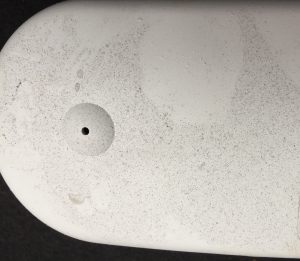
A layer of asphalt dust coated a Downwinders air quality monitor while it was recording levels of PM pollution at Marsha Jackson’s house in early March
This lack of any data to back up its air pollution claims was one of the most embarrassing parts of the hearing for the City. One wonders when James McQuire and his Office Of Environmental Quality & (Rockefeller) Sustainability’s stubborn refusal to buy its own air monitors will eventually cost the City (and its residents) in court.
But every time the City’s case looked in trouble, Blue Star’s attorney dug a deeper hole. He wanted the judge to know “shingles make really good fill” and that the spring-fed creek that ran through the company’s site was merely “a drainage ditch” and asking, after all judge, what is the true and right definition of “combustible” under Texas law?
Judge: “It means catch fire.”
Everyone but the Blue Star attorney chuckled.
After 45 minutes, Judge Gina Slaughter had heard enough and ruled in favor of the Restraining order. It took effect March 22nd and runs until Midnight on April 3rd.
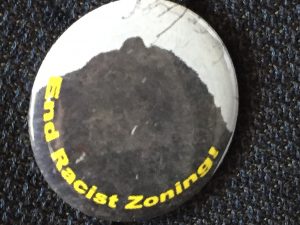 Before that happens, an 11 am Wednesday morning hearing will be held in the same courtroom to decide whether to extend the Temporary Order into a more permanent one. Word is that Blue Star was caught doing business during the last week when it wasn’t supposed to be on site at all. If true, it seems unlikely Blue Star will be granted a reprieve, despite the optimism displayed on the company’s website. “We fully expect to be open on Thursday April 4th, 2019″ it proclaims.
Before that happens, an 11 am Wednesday morning hearing will be held in the same courtroom to decide whether to extend the Temporary Order into a more permanent one. Word is that Blue Star was caught doing business during the last week when it wasn’t supposed to be on site at all. If true, it seems unlikely Blue Star will be granted a reprieve, despite the optimism displayed on the company’s website. “We fully expect to be open on Thursday April 4th, 2019″ it proclaims.
Not if Marsha Jackson, her friends in the Southern Sector Rising Campaign, and now their reluctant ally, The City of Dallas, get their way.
Take a 4 Minute Trip to “Shingle Mountain”
Read Dallas’ Shingle Mountain Restraining Order
Dallas Goes After Shingle M… by on Scribd
URGENT CALL TO ACTION FOR MARSHA JACKSON AND DALLAS’ SOUTHERN SECTOR
12 Noon, Wednesday March 20th
Dallas City Hall Flag Room 6th Floor
JOIN US FOR THE PUBLIC LAUNCH OF THE
SOUTHERN SECTOR RISING
CAMPAIGN FOR
ENVIRONMENTAL JUSTICE
Downwinders at Risk has joined with the the Joppa Freedman’s Association, Neighbors United/Vecino Unidos, the Highland Hills Community Action Committee, Sierra Club/BeyondCoal, Pax Christi Dallas, and other Dallas groups in initiating a campaign aimed at uniting residents who live along and south of the Trinity River, and their allies to say “enough is enough.”
The Southern Sector Rising Campaign for Environmental Justice seeks to end decades of racist zoning forcing industrial polluters into predominantly Black and Brown residential neighborhoods and more equitably distribute Dallas’ pollution burdens.
The Campaign’s First Target

SHINGLE MOUNTAIN
The most serious on-going environmental justice crisis in Dallas –
The Blue Star asphalt shingle sham recycling operation,
aka, “Shingle Mountain” aka “the Asphalt Alps.”
What makes this situation such a crisis?
Volume – thousands of tons of waste are accumulating with new loads arriving daily. The mountain is now4-5 stories tall.

Proximity – fine dust spewed and stored across the backyard fences of families with kids

Toxicity – Asphalt shingle waste is chock full of carcinogens
Help us apply more public pressure.
The Campaign’s First Action:

Public Launch @ DALLAS CITY HALL
WEDNESDAY MARCH 20th
12 NOON
FLAG ROOM 6th FLOOR
JOIN US AS WE PROPOSE A PRO-ACTIVE
DALLAS ENVIRONMENTAL JUSTICE AGENDA
1. The City of Dallas must immediately close the Blue Star Asphalt operation and begin to clean up the mess the company has created along the South Central corridor.
2. The City must include an equity provision in the City’s new Economic Development Policy prohibiting concentrations of polluters/pollution in the same neighborhoods.
3. The City must pass a moratorium on any new Industrial permits south of the Trinity River until that new industrial equity policy is in place.
4. The City must restore the City’s Environmental Health Commission to allow for a more resident-friendly process for hearing environmental nuisance and health problems.
5. The City must create a Joppa Environmental Preservation District prohibiting any new industrial permits in that historic Dallas Freedman’s community, phasing-out of existing industrial zoning there, and better protecting residents from pollution exposure.
March 20th’s launch at City Hall will begin with a video by local filmmaker Rick Baraff examining the personal toll Blue Star’s operations have had on the families who live around it. We’ll hear from Marsha Jackson, Biance Morales and members of her family as well as some very special guests.
It’s expected that at least one lawsuit, and maybe others, will be announced on March 20th on behalf of Ms. Jackson and the Morales’.
Campaign representatives will also be submitting language for specific ordinances the Dallas City Council to pass to implement the five campaign goals, announcing weekly pickets and a warning to the City that if Blue Star isn’t shut down by Earth Day, Monday April 22nd, we’ll be attempting to blockade new trucks of shingles from being dumped.
The Campaign’s First Protest

Picket Line at the front gate of Blue Star
12 noon to 2 pm, Saturday March 23rd
9527 S. CENTRAL EXPRESSWAY
VOTE WITH YOUR FEET TO HELP THIS NEIGHBORHOOD
IN ITS TIME OF CRISIS
This first protest at Blue Star will reflect Ms. Marsha Jackson’s deep ties to the Southern Dallas trail riding community. We’ll have a check-in tent with water, Rules of the Road and the latest information. We can supply some signs and help you create your own. The important thing is to show-up and support the effort to clean-up this horrible mess and the messes that decades of racist zoning have produced all over the Southern Sector.

Sorry Ms. Jackson: The City is Failing Southern Dallas
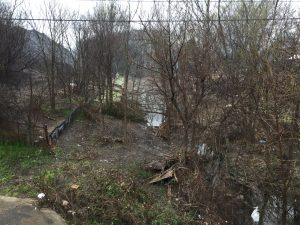
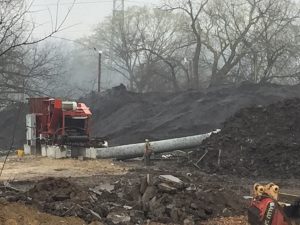
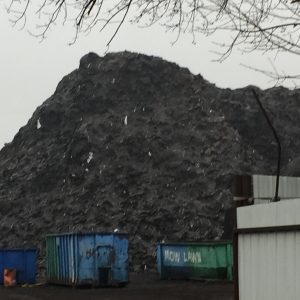
Marsha Jackson thought she’d found relief when Dallas Morning News columnist Robert Wilonsky wrote about the grotesque environmental disaster being caused by the Blue Star asphalt operation in mid-December..the first time.
After complaining almost a year to the City of Dallas, the State of Texas, and the EPA without any action taken, Ms Jackson saw Wilsonky’s column set-off a flurry of official concern about this inept and dangerous operation destroying acres of tree-covered Southern Dallas and Ms. Jackson’s home of 25 years.
That’ll happen when the city’s most read reporter informs you for the first time in passing about a situation it’s your job to already know about.
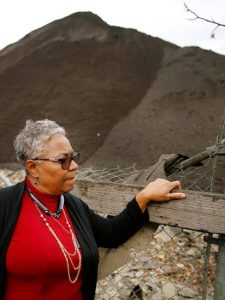 But that initial knee-jerk response left Blue Star still open for business, and without a clean-up. So Wilonsky wrote another column. Some more official action ensued. The City got a Temporary Restraining Order….that expired after a week. The authorities made Blue Star push their 4-5 story high mountains of used shingles back away from a small creek running through it’s property so the waterway would be better protected. Ms. Jackson? Not so much.
But that initial knee-jerk response left Blue Star still open for business, and without a clean-up. So Wilonsky wrote another column. Some more official action ensued. The City got a Temporary Restraining Order….that expired after a week. The authorities made Blue Star push their 4-5 story high mountains of used shingles back away from a small creek running through it’s property so the waterway would be better protected. Ms. Jackson? Not so much.
In fact, Blue Star has not been cited with even one nuisance, air pollution, or public health violation by the City of Dallas since it began building its special version of Hell a little more than a year ago. Officially, the city has shown zero concern for the human toll being taken by Blue Star’s pollution.
Last month Wilsosky wrote his third column stating what many of us feel when we see the operation in person: “This is insane.” He got Dallas City Manager T.C. Broadnax on the record saying Ms. Jackson’s plight was the result of bad zoning, the kind that allows polluters to only set-up shop south of Dallas’ historic dividing line Trinity River. But no action was taken to change that zoning and Blue Star keeps right on accepting truckloads of old shingles and keeps grinding them up in the open-air using the industrial equivalent of giant wood chippers, spewing fiberglass, plastic and maybe asbestos into Ms. Jackson’s property and neighborhood.
Blue Star keeps operating even though the City of Dallas says the business didn’t have a Certificate of Occupancy when they opened, despite evidence current city zoning doesn’t allow what they’re doing on the property they’re doing it on, and despite evidence they don’t have all the environmental paperwork they need for the despoiling taking place.
Despite his best efforts to do the job the City and State are supposed to be doing, Wilonsky’s words just haven’t been enough to stop the obscene environmental and public health problems being caused daily by Blue Star.
So maybe it’s time to do this ourselves.
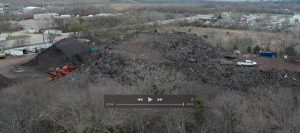
Maybe it’s time to file some lawsuits of our own, as citizens. There’s now plenty of documentation to prove the case of destruction, property rights takings, and personal and public health problems. Are there lawyers working in the public interest who could pursue these on behalf of Ms. Jackson and her neighbors? Yes there are. There are ones who can sue for regulatory relief and others who sue for “personal damages” caused by this kind of reckless disregard. These “toxic tort” attorneys would do well to target the deep pockets of the City of Dallas and the State of Texas as well as the modest holdings of Blue Star. Often the way to permanently put a stop to this kind of thing is to make the responsible parities pay such a high price that they’re never even tempted to try it again.
Maybe it’s time for us to begin amortization proceedings against Blue Star. This is the process that closed the RSR lead smelter in West Dallas in the 1980’s. A city can change the zoning for a piece of property to something that clearly does not allow the current activity to take place on that property. In order to be fair, the law allows the current users to operate until they get their investment in the property back and then they have to close-shop and move. Once you see the Blue Star property, you’ll understand that it’ll take about a day and a half for the company to get back its “investment.” In fact, because of all the violations of law and probable lawsuits, Blue Star is probably already close to being in the red.
Amortization proceedings can be initiated by the City Council OR citizens themselves. Here’s a description from the Dallas City Code using the City’s 15-member, council-appointed Board of Adjustments:
§ 51A-4.704. Nonconforming Uses And Structures.
The city council may request that the board of adjustment consider establishing a compliance date for a nonconforming use. In addition, any person who resides or owns real property in the city may request that the board consider establishing a compliance date for a nonconforming use. Upon receiving such a request, the board shall hold a public hearing to determine whether continued operation of the nonconforming use will have an adverse effect on nearby properties. If, based on the evidence presented at the public hearing, the board determines that continued operation of the use will have an adverse effect on nearby properties, it shall proceed to establish a compliance date for the nonconforming use; otherwise, it shall not.
Ms. Jackson owns her house. So maybe it’s time we help her petition the Board of Adjustments to begin kicking Blue Star out of Southern Dallas ourselves. If the Council wants to do its job and join in, that w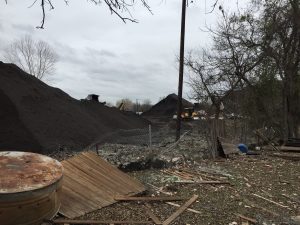 ould be great. But we don’t need them to start the ball rolling.
ould be great. But we don’t need them to start the ball rolling.
Maybe it’s time we protested. Not just on behalf of Ms. Jackson, but the ancient, racist underlying cause of this awful situation and so many more south of the Trinity River. Everyone who lives in the “Southern Sector” is a current or potential Marsha Jackson. We’ve got to begin to change the entire zoning map of the city to get rid of the kind of outrages even the City Manager acknowledges are a problem. We need to demonstrate not just against Blue Star, but for improvement across the board, for real progress on the City’s own Master Plan for South Central that aims to “de-industrialize” the area – not make it into a wasteland. We need a platform for progress that address the Southern Sector as a whole instead of continuing to play whack-a-polluter every few months at a different location.
Since August, T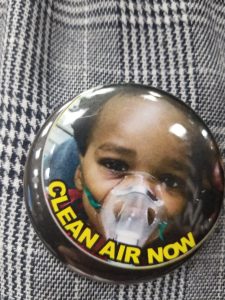 he Let Joppa Breathe Alliance has been meeting to try and draft such a platform as part of its mission. It’s been recruiting allies south and north of the river. It’s very near to making an announcement about that platform and the means it will begin to pursue it. This platform will be the first attempt to articulate specific City of Dallas environmental justice policy changes in the City’s history. It represents a tectonic shift in responding to age-old discrimination that’s still leaving a huge dusty coal-like legacy in Southern Dallas. We’re tired of playing defense. Its time we set the agenda.
he Let Joppa Breathe Alliance has been meeting to try and draft such a platform as part of its mission. It’s been recruiting allies south and north of the river. It’s very near to making an announcement about that platform and the means it will begin to pursue it. This platform will be the first attempt to articulate specific City of Dallas environmental justice policy changes in the City’s history. It represents a tectonic shift in responding to age-old discrimination that’s still leaving a huge dusty coal-like legacy in Southern Dallas. We’re tired of playing defense. Its time we set the agenda.
Dallas City Hall has failed Ms. Jackson and her neighbors. It’s failed Joppa. It’s failed Cadillac Heights, and Highland Hills and Fruitdale, and West Dallas. Over and over again. To win progress, something more must be done. When the call comes for that something more, how will you respond?
Downwinders At Risk c4 Board Endorses Scott Griggs for Dallas Mayor
Also expected to quiz School Board candidates on electric buses
Citing his role in stopping illegal gas drilling in Dallas, opposition to the Trinity River toll road road, and healthy skepticism of City Hall bureaucracy, the “c4” board of Downwinders at Risk voted to endorse Scott Griggs for Dallas Mayor at its February meeting.
“No one else running for Mayor has done as much to protect Dallas residents from very bad ideas, often against very big odds, than Scott Griggs” said Downwinders at Risk Director Jim Schermbeck. “No other candidate even has a track record of environmental accomplishments, much less one that includes slaying Goliaths like “done deal” gas drilling or the zombie toll road. If you want to be sure Dallas will be Greener in deed as well as rhetoric, there’s really only one choice this time.”
Griggs was first elected to the Dallas City Council in May 2011 representing then-District 3 including West Dallas, Oak Cliff, and Mountain Creek neighborhoods. After redistricting in 2013, Griggs was reelected to represent residents of North Oak Cliff in the redrawn District 1. He was reelected again in 2015 and 2017. In his first term Scott was voted as the 2012 Best Politician by D Magazine and the Dallas Observer. He’s known as a studious council member who’s often more prepared to talk about city policy than city staff.
Griggs was a well-received special guest speaker at Downwinders’ 1-Day University this last December, where he brought his daughter Catalina along on their way to a dance recital.
 Along with the mayoral endorsement, the c4 board also voted to send a questionnaire to Dallas Independent School District board candidates asking about their support for school bus fleet electrification. It’s believed to be the first time bus electrification has shown up as an issue in a DISD election.
Along with the mayoral endorsement, the c4 board also voted to send a questionnaire to Dallas Independent School District board candidates asking about their support for school bus fleet electrification. It’s believed to be the first time bus electrification has shown up as an issue in a DISD election.
While non-profit c3 boards must devote the majority of their time and money to educational efforts, c4 boards are allowed wide latitude in advocating, lobbying and contributing to campaigns. Like many non-profits Downwinders at Risk has both.
Dallas Climate Plan’s “Public Participation” is Neither Very Public nor Participatory
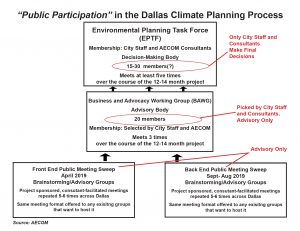
Despite supporters’ claims that the new $500,000 Dallas Climate “Action” Plan would have lots of opportunities for public participation, the decision-making apparatus drafting the plan puts all the decision-making power in the hands of City staff and its hired consultants.
Meet the New Boss. Same as the Old Boss.
Oh, they’ll be countless PowerPoint presentations and “brain storming” sessions around the city over the next year in meetings sponsored by City Hall and neighborhood associations, but those will have exactly zero official standing in the final plan. Suggestions and comments will be harvested but they don’t have to be included – not even if they’re extremely popular in all those meetings.
Those community meetings are the foundation for the process AECOM consultants outlined at the City’s Climate Symposium on February 4th. They’re at the very bottom of the plan’s purported decision-making pyramid. This MO is familiar to anyone dealing with Dallas City Hall in the recent past: “We’re happy to give you all the well-publicized public meetings you want. Just don’t ask us to let the public in the room when the actual decisions are being made.”
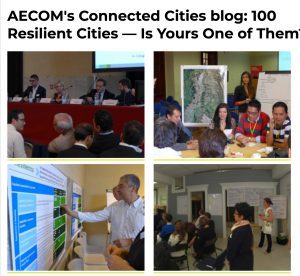 To maintain the illusion of someone other than city staff and consultants being involved, there’s a 20 member “Business and Advocacy Working Group, or “BAWG” (pronounced like the noun describing the soft ground formed by decaying plants, but also like the British slang term for a toilet, as in “Do you have any Bog/BAWG paper? We ran out.” Either metaphor is probably apt here.)
To maintain the illusion of someone other than city staff and consultants being involved, there’s a 20 member “Business and Advocacy Working Group, or “BAWG” (pronounced like the noun describing the soft ground formed by decaying plants, but also like the British slang term for a toilet, as in “Do you have any Bog/BAWG paper? We ran out.” Either metaphor is probably apt here.)
This august body will be, let’s see, what was the very civilized term used by the AECOM consultant at the Symposium? “Curated,” that’s it. The BAWG members will be “curated” by city staff and AECOM. We thought that was such a precious term for “hand-picked by the Powers-That-Be.”
So City Hall and AECOM will hand pick the 20 members of this working group, at least half of whom will be Dallas “Bidness” folk. That leaves 10 or less slots for “advocates” like the Texas Tree Foundation, the Texas Nature Conservancy, and other City Hall friendly-groups who are allies or have the blessing of Dallas (Rockefeller) “Resilency” Czarina Theresa O’Donnell. Of course O’Donnell proved her green bone fides earlier this decade when she passionately defended the idea of drilling for gas in Dallas public parks.
Despite other cities singling-out “equity” concerns for their own tracks, there’s absolutely official zero intent in the Dallas Office of Environmental Quality and (Rockefeller) Sustainability to do so here. Not even after going around the last six months proclaiming how concerned City Hall was about black kids with asthma. Local environmental justice advocates approached the OEQ(R)S last month with the idea of establishing an “equity working group” as part of the public participation process. They were told the City wasn’t interested.
Remaining remarkably consistent with their current management philosophy city staff dismissed the idea that more Dallas residents being involved in the planning process was a good thing. When the EJ groups brought up the recently-completed San Antonio plan which established not only a business-environmentalist steering committee but working groups on “Energy and Buildings,” “Transportation and Land Use,” “Solid Waste Resources, ” Water and Natural Resources,” and “Equity,” staff responded that San Antonio City Hall had warned them to avoid all that democracy. “There were too many people involved down there” was the reply, which will surely come as a surprise to the 86 San Antonio activists who participated.
Despite all this official gate-keeping surrounding the Climate Plan’s BAWG/BOG membership in Dallas, the actual on-the-paper influence of this curated working group is questionable since it only meets 3 times over the course of the year long drafting process. For most of those 12 months this “working group” is unemployed.
Which brings us to the real decision-makers at the top of the pyramid, the “Environmental Planning Task Force, or “EPTF.” Gesundheit!
Comprised exclusively of city staffers and consultants, this Task Force will oversee the day-to-day machinations of the climate plan, and most importantly what recommendations to include, or not, and what timelines are “realistic” vs “not practical.” While there’s a patina of public participation in its “listening tours” the final arbiters of Dallas’ climate plan remain completely removed from public transparency, accountability and meaningful participation.
It didn’t have to be this way, at least not without a fight.
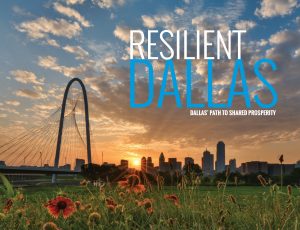 The same mainstream green groups that signed-off on City Hall using Dallas’ moribund plastic bag fund to pay for this plan could have demanded authentic public participation in return for their support. They could have asked for Southern Sector groups to have their fair share of representation at the table. They could have requested multiple resident-staffed working groups like San Antonio. They could have asked for real oversight and decision-making. Dallas City Hall needed them and their lobbying last August during the budget town hall meetings, but they gave up their leverage without asking for anything in return (that we know about anyway). This current public participation plan that really isn’t, is the result.
The same mainstream green groups that signed-off on City Hall using Dallas’ moribund plastic bag fund to pay for this plan could have demanded authentic public participation in return for their support. They could have asked for Southern Sector groups to have their fair share of representation at the table. They could have requested multiple resident-staffed working groups like San Antonio. They could have asked for real oversight and decision-making. Dallas City Hall needed them and their lobbying last August during the budget town hall meetings, but they gave up their leverage without asking for anything in return (that we know about anyway). This current public participation plan that really isn’t, is the result.
As we noted in our last post about this subject, perhaps the only good thing about this process is that’s it gives Dallas residents a chance to upset the cart with their own ideas about how a climate plan for the city should be assembled. There’s already rumblings about a citizens’ planning process to shadow the staff’s version and provide an honest measuring stick for it. That would be a good idea. Unlike city staff, Downwinders believes the more people in the room, the better the decisions being made.

